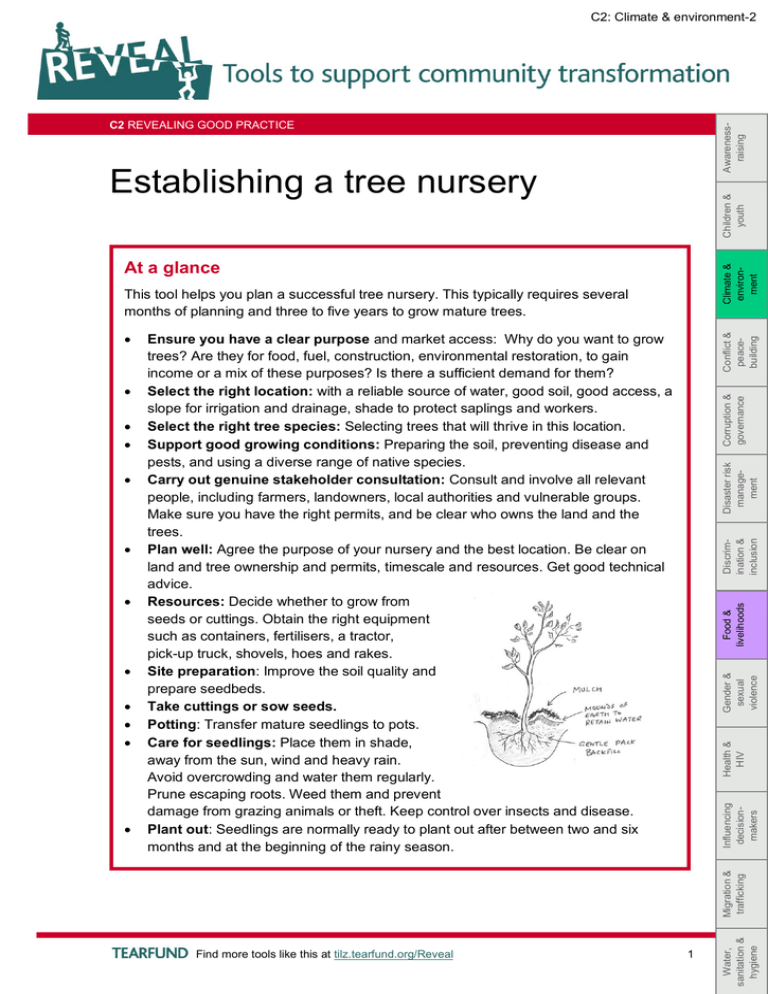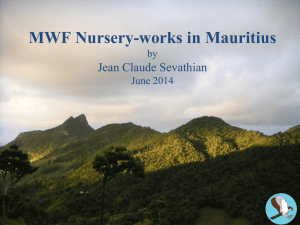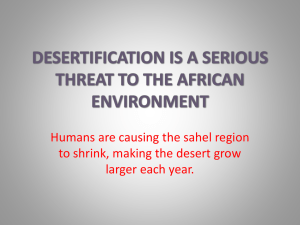Document 10783769
advertisement

C2: Climate & environment-2 Awarenessraising C2 REVEALING GOOD PRACTICE Children & youth Establishing a tree nursery Climate & environment At a glance Corruption & governance Disaster risk management Discrimination & inclusion Food & livelihoods Gender & sexual violence Health & HIV Influencing decisionmakers Migration & trafficking Ensure you have a clear purpose and market access: Why do you want to grow trees? Are they for food, fuel, construction, environmental restoration, to gain income or a mix of these purposes? Is there a sufficient demand for them? Select the right location: with a reliable source of water, good soil, good access, a slope for irrigation and drainage, shade to protect saplings and workers. Select the right tree species: Selecting trees that will thrive in this location. Support good growing conditions: Preparing the soil, preventing disease and pests, and using a diverse range of native species. Carry out genuine stakeholder consultation: Consult and involve all relevant people, including farmers, landowners, local authorities and vulnerable groups. Make sure you have the right permits, and be clear who owns the land and the trees. Plan well: Agree the purpose of your nursery and the best location. Be clear on land and tree ownership and permits, timescale and resources. Get good technical advice. Resources: Decide whether to grow from seeds or cuttings. Obtain the right equipment such as containers, fertilisers, a tractor, pick-up truck, shovels, hoes and rakes. Site preparation: Improve the soil quality and prepare seedbeds. Take cuttings or sow seeds. Potting: Transfer mature seedlings to pots. Care for seedlings: Place them in shade, away from the sun, wind and heavy rain. Avoid overcrowding and water them regularly. Prune escaping roots. Weed them and prevent damage from grazing animals or theft. Keep control over insects and disease. Plant out: Seedlings are normally ready to plant out after between two and six months and at the beginning of the rainy season. Find more tools like this at tilz.tearfund.org/Reveal 1 Water, sanitation & hygiene Conflict & peacebuilding This tool helps you plan a successful tree nursery. This typically requires several months of planning and three to five years to grow mature trees. C2: Climate & environment-2 C2 ESTABLISHING A TREE NURSERY Why use this tool? Awarenessraising Children & youth This tool helps you decide whether and how to plan and start a successful tree nursery. Trees can provide food, fuel and construction materials. They can protect water resources, soil quality, slope stability and biodiversity. They can support livelihoods and even help reduce the impacts of climate change. Despite these benefits, forests are being cut down at an alarming rate. Climate & environment A brief description Conflict & peacebuilding This tool will help you think about why, where and how you can grow trees. There are many approaches to growing trees. The approach you take will depend on the purpose you have chosen. The most helpful way for the community to decide on their approach is to think about the main reasons they want to grow trees. Corruption & governance Disaster risk management Discrimination & inclusion Reason for growing trees Possible approaches Improving health and nutrition Fruit trees at household level. Encouraging biodiversity, reversing environmental degradation or climate change, or improving the water cycle Growth of large woodlands – conservation forest Income generation – timber for livelihoods or domestic use such as firewood, charcoal, fruit, construction, fodder, handicrafts, medicinal purpose Sustainably managed forest To meet market demand by making good-quality, uniform, disease-free tree seedlings available Develop a seed nursery Food & livelihoods Explaining the words we use Gender & sexual violence Environment – the physical and natural world around us, including land, water, oceans, climate, plants and animals Climate change – changes in weather patterns in an area over time, caused by human activities Biodiversity – the variety of animal and plant life in an area Health & HIV Time taken Planning will take several months. Influencing decisionmakers Migration & trafficking The growth of mature trees takes at least three to five years. Sustainable management of mature woodland is over decades. Participants will need to be committed to regular activities including weeding, watering, protection from disease, pests, grazing and preventing theft. Water, sanitation & hygiene Find more tools like this at tilz.tearfund.org/Reveal 2 C2: Climate & environment-2 C2 ESTABLISHING A TREE NURSERY You will need Children & youth Awarenessraising land & permits – trees can be grown on small or large areas tools – spades, hoes, rakes and access to tree seeds (whether from the wild or purchased) and fertilisers (such as fertilisers or homemade composts – see Tool C2 – Composting) Keys to success Conflict & peacebuilding Climate & environment A good site needs: A consistently reliable local water source. Is a permit needed for using the water? Good-quality soil, or a plan to make fertile soil. Access to gather or buy seedlings or cuttings. A gentle slope over well-drained soil. Shade to protect the trees and the nursery workers, such as existing trees, the lee of a hill, or bamboo fences. Disaster risk management Corruption & governance Tree species Before you choose research local growing conditions: disease, pests, competition, opposition, native species, natural biodiversity. Avoid single species – this risks spreading disease and prevents biodiversity. Find suitable native species that are resilient to changes in climate. Look for trees resilient to pests and disease. Influencing decisionmakers Health & HIV Gender & sexual violence Food & livelihoods Discrimination & inclusion Stakeholder participation Include farmers, landowners, local authority, construction workers, women. How can your project specifically support women and vulnerable groups who typically have fewer rights to own land and less access to markets or business advice? Who owns the land? Who will own the mature trees? Who owns access routes? How can you foresee and avoid conflict such as competition for grazing or food crops? Do you have the right permits? Do you need a contract with the landowner to protect the rights of both parties - yours and his/hers? Trees grown on communal land belong to everyone and will require agreements with different people. Will new local by-laws be needed to protect them? Trees grown for construction material or firewood could be in shared ownership, or private ownership as part of someone’s livelihood. In this instance, sustainability is achieved by ensuring the money received from sale of the timber covers all of the costs and provides some profit. It is also a good idea to check with local or national agriculture or environment departments to ensure that no planning laws are broken. Find more tools like this at tilz.tearfund.org/Reveal Migration & trafficking Market access If you are aiming to sell timber, will it be sold locally or transported some distance? Is there enough demand in the market for the product you are hoping to sell? Do you need a business licence if you are growing trees in order to sell something? 3 Water, sanitation & hygiene C2: Climate & environment-2 C2 ESTABLISHING A TREE NURSERY What to do Awarenessraising Children & youth Climate & environment Conflict & peacebuilding 1. Planning Planning a tree nursery includes working with the local community and other key people to determine the following: the purpose of your tree nursery location, ownership, permissions timescale resources and other inputs required species selection, technical advice end use of the trees Could you develop a business plan that outlines all of these? The plan should also consider the resources needed and start-up costs. Could you consider a communitybased saving and credit scheme? Corruption & governance 2. Resources: seeds, equipment Disaster risk management Discrimination & inclusion Can you harvest sufficient seeds, seedlings or cuttings from the wild? What is the cost to purchase? Do you need to import? Equipment needed may include: containers, fertilisers, a tractor, pick-up truck and trailer, as well as shovels, hoes, rakes etc. Estimate the equipment you need so you can produce a costed business plan. Food & livelihoods 3. Site preparation: soil, water/ irrigation, shade Good soil quality is essential for thriving trees. Not all trees need the same soil types. Planting a variety of species over time, starting with nitrogen-fixing species such as the Acacia tree, red-hot-poker tree, and turpentine tree, can improve the soil quality. Gender & sexual violence Health & HIV Influencing decisionmakers A typical soil for tree nurseries consists of: three parts organic / dark soil – such as dug from under existing vegetation two parts clay soil one part sand A typical soil quality test is to roll a small lump of soil in your hand. If it holds its shape when rolled, but snaps when bent, it should be suitable. Soil that crumbles contains too much sand. Soil that doesn’t easily break contains too much clay. Migration & trafficking Soil quality can be improved by adding one part manure or compost to every three parts of the mixed soil. Water, sanitation & hygiene Find more tools like this at tilz.tearfund.org/Reveal 4 C2: Climate & environment-2 C2 ESTABLISHING A TREE NURSERY Taking cuttings Cuttings are normally taken when seeds are not easily available. Examine the tree to ensure it is healthy. Cuttings should be side branches, not from the crown of the tree. Cut branches should have at least two bud scars, preferably three or four. Remove the leaves. The branch should be cut at 45 degrees. Cut 10–20cm lengths from smaller trees and 20–45cm lengths from large trees. Put the cutting in water for a few minutes, then place it into a pre-made hole in a plant pot or seedbed. Space your cuttings evenly, maximum four to a 40cm-wide pot. Press the soil around the cuttings to ensure there are no pockets of air and lightly water them. Find more tools like this at tilz.tearfund.org/Reveal Children & youth Climate & environment Conflict & peacebuilding Corruption & governance Food & livelihoods Discrimination & inclusion Most trees can be established from seed or from cuttings. However, seeds can be hard to come by and take more time and resources to protect and nurture. Consult your local agricultural authority or local farmers for advice. However, it’s important that you do not establish all of your trees from cuttings from the same tree or its descendant. If all cuttings originate from the same tree, they are clones, which means that, if one is hit by disease or pest, the problem will very easily spread to all the others. Disaster risk management 4. Seeds or cuttings? 5 Gender & sexual violence Health & HIV Influencing decisionmakers Migration & trafficking Seedbeds are usually constructed on top of the existing ground level. This reduces the amount of work involved and makes them more accessible to work on (watering, weeding, pruning and transplanting). Seedbeds are ideally located on a gentle slope to improve water retention, and narrow enough (approximately one metre) to make it easy to maintain the seedlings. The seedbed can be any length. Dig a shallow trough around the edges of the seedbed and fill these with material such as timber, brick, or stones to form the four supporting sides of the bed. The height of the sides should be at least 15cm. They can be any height above this, but a higher bed will require more soil within it. A shallow layer of small stones can be placed across the bottom of the bed to provide drainage. A layer of prepared soil is placed on top of the stones. This can be as shallow as five –10 centimetres. Water, sanitation & hygiene Awarenessraising Seedbed preparation C2: Climate & environment-2 C2 ESTABLISHING A TREE NURSERY Awarenessraising Children & youth Provide shade so the cuttings are not in direct sunlight. Gently water the cuttings every other day or when the soil is dry to touch. Don’t overwater or the roots will rot. Don’t disturb the soil around them as this will damage or kill them. Smaller trees normally grow new leaves and shoots after about a month. Keep watering and feeding the saplings for about three months, until they have plenty of leaves, before transplanting them. Climate & environment Conflict & peacebuilding Corruption & governance Sowing seeds Large seeds should be sown in drills (lines) running across the seedbeds, about 5–10 cm apart. Smaller seeds can be scattered over the seedbed and pressed into the soil, for example with a piece of wood. Very small seeds should be first mixed with fine sand or soil before sowing to help space them out. When sown, spread a thin layer of fine soil (or sand) to about 5mm depth. Water regularly, up to twice a day if it is hot dry weather, but be careful not to overwater or the seeds will rot. Disaster risk management Discrimination & inclusion Food & livelihoods Gender & sexual violence 5. Potting Seedlings should be transferred to pots to avoid them choking each other. Do this when they have several mature leaves. Pots can be made of any local material, including polythene bags. Transplanting damages the roots, so is best done at the start or end of the day to avoid wilting. The seedlings should be well watered before transplanting. Prepare the pots by filling with soil and make a hole with a stick in the middle, to the same depth as the seedling roots. Insert a trowel or stick well underneath seedlings to lift them. Never pull them by the stem. Place them in water if you cannot pot straight away. Gently place seedlings in the hole and press soil around them to remove any air pockets. Water immediately and place the potted seedlings together in a shaded area. Health & HIV Influencing decisionmakers Migration & trafficking 6. Care of seedlings Seedlings should be cared for, including the following measures: Provide shade and shelter from the sun, wind and heavy rain. Avoid overcrowding which would limit growth due to lack of nutrients and water. Water regularly to protect seedlings from wilting. Prune any roots escaping from the pots to protect them from breaking when planted out. Weed regularly to avoid competition for nutrients. Fence off to prevent damage from grazing animals or theft. Water, sanitation & hygiene Find more tools like this at tilz.tearfund.org/Reveal 6 C2: Climate & environment-2 Conflict & peacebuilding Climate & environment Seedlings are usually planted out at the beginning of the rainy season as that is the time they can become established and develop their root networks. Seedlings continue to require care, particularly from grazing animals, with fencing or tree guards. Disaster risk management World Agroforestry Centre (2009): Good nursery practices: a simple guide: worldagroforestry.org/downloads/publications/PDFs/MN15937.PDF PACE Action Sheet 49 (1999): Tree planting http://www.paceproject.net/Userfiles/File/Forests/tree%20planting.pdf PACE Action Sheet 36 (1996): Planting nitrogen fixing trees paceproject.net/Userfiles/File/Soils/planting%20nitrogen.pdf World Agroforestry Centre worldagroforestry.org Food and trees for Africa: www.treez.org.za Discrimination & inclusion Corruption & governance Finding out more Children & youth 7. Planting out Food & livelihoods Notes Gender & sexual violence The same procedure for establishing a tree nursery can be used for vegetables, medicinal plants or cut-flower nurseries. Migration & trafficking Influencing decisionmakers Health & HIV Related tools: A1 – Revealing environmental degradation: information for facilitators [A1: Climate & environment-2] A2 – Different ways of adapting to climate change [A2: Climate & environment-1] B – Caring for God’s world (Bible study) [B: Climate & environment-2] B – Caring for our environment (Bible study) [B: Climate & environment-3] B – Stewardship of the land (Bible study) [B: Climate & environment-4] C2 – Composting [C2: Climate & environment -1] C2 – Starting a business [C2: Food & livelihoods-6] C2 – Developing rural home gardens [C2: Food & livelihoods-8] C2 – Developing urban home gardens [C2: Food & livelihoods-9] Find more tools like this at tilz.tearfund.org/Reveal 7 Water, sanitation & hygiene Control insects and diseases, including ‘damping off’, a form of fungal infection caused by low light levels, low air circulation, low temperatures or overcrowding of the seedlings. Seedlings are normally ready to plant out after between two and six months. A few weeks before planting them out, start to reduce the shade and amount of water to make them more resilient to being planted out. Awarenessraising C2 ESTABLISHING A TREE NURSERY







